If you have a passion for a particular plant or group of plants
or just enjoy sharing your growing joys and sorrows, there are
groups of like-minded gardeners all across Central New York. Below
is just a sampling of these groups along with the most recent
contact information that I can find - including websites, if
available - above, at right.
If you're aware of a group that's not included here, or have
updated contact information for a listed group, click on the
"Contact" link at the bottom of this page to send me a note.
Syracuse Rose Society
Founded in 1911, this is the oldest rose society in continuous existence in the United States!
It's also probably one of the busiest as its members maintain one of
the larger public rose gardens in the eastern U.S. For more
information, click on the link to the group's website, at right.
Men's Garden Club of Syracuse
Despite its name, this club welcomes
women, too. In fact, if I'm not mistaken, most of the group's
officers are currently women (whom I understand are much better at
getting things done)! The club is very active in a number of local
public gardening efforts. For more information, call 315-727-2182.
Central New York Orchid Society
Orchids are considered to be among the most exotic of all cultivated plants. And, while many
are very difficult to grow, others are surprisingly easy. If you'd like to learn more about growing this fascinating
group of plants, this organization features an enthusiastic,
knowledgeable, helpful and active membership! For more
information, click on the link to this group's informative website, at right.
Bonsai Club of Central New York
Bonsai are right at the top of my list of
fascinating plants. This is not only because the depiction of
oftentimes very large plants in miniature, but also because many of
the most common bonsai actually need exposure to cold temperatures
over the winter months to thrive. If you'd like to learn more about
this group, click on the link to their website at right.
Habitat Gardening in Central New York
A habitat garden provides the same kinds of things for birds, butterflies, and other creatures
that people need in their own "habitat": food, cover, water, and a place to raise young in a healthy environment. These
requirements can be met even in small spaces with careful planning. This group of very dedicated habitat gardeners can help
you learn how to create a sanctuary for all sorts of critters that's also visually stunning throughout the year! Their
"Show Me, Help Me" summer garden tours can be especially helpful -
and fun, too! For more
information, click on the link at right.
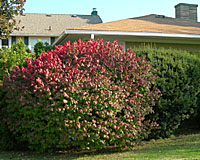 Not too surprising, at least to me, is that there are a lot of people struggling with how to best manage overgrown shrubs. Specifically,
visitors to this site want to know how to control the size of burning bush, at right, rose-of-Sharon, and evergreen trees and shrubs.
Visitors also want to know when and how far back to prune butterfly
bush!
Not too surprising, at least to me, is that there are a lot of people struggling with how to best manage overgrown shrubs. Specifically,
visitors to this site want to know how to control the size of burning bush, at right, rose-of-Sharon, and evergreen trees and shrubs.
Visitors also want to know when and how far back to prune butterfly
bush!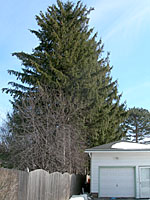 questions relating to the creation of privacy in landscape settings.
questions relating to the creation of privacy in landscape settings.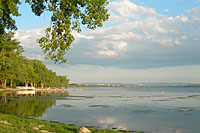 Each winter, the Central New York State Nursery & Landscape Association delivers an educational
program for its members and other "green" industry representatives including golf course superintendents, landscape architects,
institutional grounds maintenance staff, and others.
Each winter, the Central New York State Nursery & Landscape Association delivers an educational
program for its members and other "green" industry representatives including golf course superintendents, landscape architects,
institutional grounds maintenance staff, and others.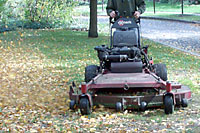 If you've spent time on this website, you
probably know that
If you've spent time on this website, you
probably know that
 Now, researchers at Michigan State University, where much of the
original research on the effect of tree leaves on lawns was
conducted, are taking a closer look at the possible herbicidal
activity of chemicals leaching out from shredded maple leaves.
Initial observations suggest that these naturally-occurring
chemicals can significantly reduce dandelion seed germination in
lawns!
Now, researchers at Michigan State University, where much of the
original research on the effect of tree leaves on lawns was
conducted, are taking a closer look at the possible herbicidal
activity of chemicals leaching out from shredded maple leaves.
Initial observations suggest that these naturally-occurring
chemicals can significantly reduce dandelion seed germination in
lawns!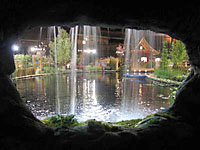 I know it seems sort of silly to start mentioning flower and garden shows that are almost six months - and likely well over one hundred
inches of snow - away!
I know it seems sort of silly to start mentioning flower and garden shows that are almost six months - and likely well over one hundred
inches of snow - away! 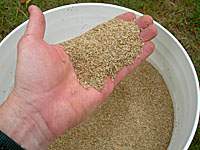 What started out as a bit of experiment has become a modest success.
What started out as a bit of experiment has become a modest success.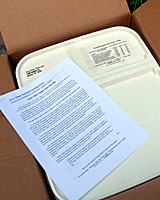 More surprisingly, because of the partnership with Drew Kinder and his company, the Seed Super Store in Buffalo,
these mixes have found there way onto lawns near West Point, out on Long Island and in Ohio, Pennsylvania,
New Jersey, and Virginia. A couple of pounds were even shipped as far south as Atlanta, Georgia!
More surprisingly, because of the partnership with Drew Kinder and his company, the Seed Super Store in Buffalo,
these mixes have found there way onto lawns near West Point, out on Long Island and in Ohio, Pennsylvania,
New Jersey, and Virginia. A couple of pounds were even shipped as far south as Atlanta, Georgia!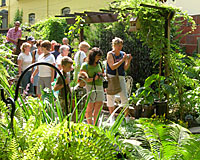 Several weeks ago I mentioned on this page (scroll down this page) that my wife, Beth, and I would be traveling to Buffalo during the last
week in August to attend the "GardenWalk" garden tour.
Several weeks ago I mentioned on this page (scroll down this page) that my wife, Beth, and I would be traveling to Buffalo during the last
week in August to attend the "GardenWalk" garden tour. Dealing with weeds is probably the worst part of gardening. This task is even worse when you're attempting to control an
especially aggressive weed such as goutweed, at right (which more than a few people unwittingly import into their
garden as tiny root pieces hidden among the roots of a "gift plant" from friends, family or neighbors)!
Dealing with weeds is probably the worst part of gardening. This task is even worse when you're attempting to control an
especially aggressive weed such as goutweed, at right (which more than a few people unwittingly import into their
garden as tiny root pieces hidden among the roots of a "gift plant" from friends, family or neighbors)!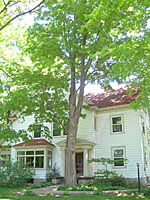 About
a month ago, I met with a couple to discuss the condition of the
trees surrounding an older home that they'd just purchased.
About
a month ago, I met with a couple to discuss the condition of the
trees surrounding an older home that they'd just purchased. 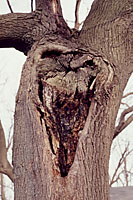 While
many conditions associated with tree failure are pretty obvious, at
left, others are almost undetectable - unless you know what you're
looking for.
While
many conditions associated with tree failure are pretty obvious, at
left, others are almost undetectable - unless you know what you're
looking for.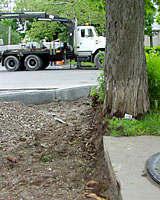 First, and foremost, the various American
elm varieties currently
in the news - including `Princeton,' `Valley Forge,' `Delaware,'
`New Harmony,' `Independence,' and others - are Dutch Elm Disease (DED) -
"tolerant", NOT "resistant!"
First, and foremost, the various American
elm varieties currently
in the news - including `Princeton,' `Valley Forge,' `Delaware,'
`New Harmony,' `Independence,' and others - are Dutch Elm Disease (DED) -
"tolerant", NOT "resistant!" 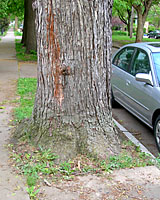 I
would also think twice before planting DED-tolerant American elms
along city streets because they're simply very large trees -
assuming they live to maturity! All of the varieties mention above,
for example, can grow anywhere from fifty to eighty feet tall and
wide, with trunks that can easily be four to five feet in diameter -
or larger! Considering that there's often no more than five feet
between the street curb and sidewalk in many neighborhoods, just
where, exactly, are these trees going to be planted?
I
would also think twice before planting DED-tolerant American elms
along city streets because they're simply very large trees -
assuming they live to maturity! All of the varieties mention above,
for example, can grow anywhere from fifty to eighty feet tall and
wide, with trunks that can easily be four to five feet in diameter -
or larger! Considering that there's often no more than five feet
between the street curb and sidewalk in many neighborhoods, just
where, exactly, are these trees going to be planted?